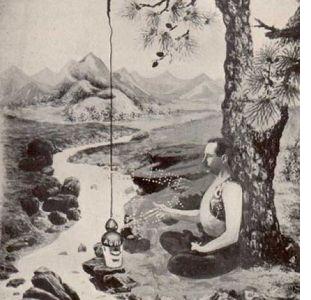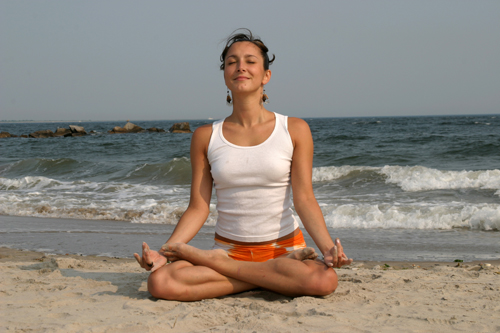A practice reported to have started as early as 3000 B.C., the word yoga originates from the sanskrit root “yoke” which implies improving the way of life through self discipline. Unlike a religious faith, the practice of yoga appeals to many people as an opportunity for self development and discipline. Therefore, Yoga is an ancient science and practice has seen a renewed interest and an upsurge in the last century. This can be attributed to the changing life style, stressed running after the material needs, and landing oneself on the doorstep new age gurus. Yoga developed through various civilizations and spread to all parts of the world more than ten thousand years ago. According to mythical traditions, Shiva, the Lord is said to be said to be the founder of yoga and Parvati, is considered to be his first disciple. Many statues of Shiva and Parvati in various poses of asanas and meditation have been unearthed in the ruins of Indus Valley Civilization.

Yoga arose along the human civilization with man realizing his spiritual potential and an urge to evolve techniques to develop various practices. Yoga as a science evolved slowly with ancient sages. It is considered as a divine gift revealed to these Sages so that man could have the opportunity of understanding and realizing his divine nature. Earlier, the yoga techniques were kept a secret and were never written down or exposed to the public. These techniques were passed on from the teacher or the guru to the disciple more by word than by written.
The first written references of the Yoga are the Tantras and later on the Vedas written during the Indus Valley Civilization. Yoga took its more definite form in the Upanishads.
The first definitive and unified comprehensive treatise on system of Yoga has been authenticated by Sage Patanjali’s Raja Yoga. His system encompasses an eight fold path, comprising of yama, niyama,asana, pranayama, pratyhara, dharana,dhyana and samadhi, i.e self restraint, self-observance, postures, breathing, dissociation of consciousness from outside environment, concentration and determination, meditation and identification and awareness with pure consciousness respectively. Including a series of dedicated meditation, relaxation techniques through breathing control and various manipulating postures of the body, practicing Yoga regularly allows you to feel aligned to the self and in harmony with your surroundings. As a result, you feel refreshed and energized, giving you a more focused approach to handle situations. Regularly performing the Yoga exercises not only enhances conscious awareness over the involuntary functions in the body but also strengthens and increases the muscle tone of weak muscles. The art of breathing as learned by a yoga student helps him/her lead a better life towards prosperity and well being. Also, the self discipline techniques fostered by Yoga aid in improving bowel movement, sleeping and eating habits thus reducing the excess stress on the body. The yoga exercises taught by the gurus are brought about in different forms by manipulating the body posture. These forms are popularly known as Asanas and involve every position from standing to sitting, laying down, one and both feet balancing, stretching, twisting, contracting and relaxing muscles and kneeling just to name a few. It is advised for beginners to start the practice of yoga at a very slow pace to get the understanding of the movement. Once you feel that you are able to perform the movement smoothly you can increase the pace and the number of repetitions or amount of time and breaths of each pose. Thus, the intensity at which the asanas are performed and the breathing patterns of the individual are very crucial to yoga exercises. Finally, perform these movements in a well ventilated, lit up and open space and remember to keep a bottle of water to hydrate yourself at all times.
As mentioned earlier, optimal breathing is very important to be able to perform the yoga exercises to get the maximum benefit. Yoga describes “breath” as Prana or a powerful force that is present in the universe that helps one find the balance between the conscious and unconscious mind. Like India, many cultures in world consider the process of breathing as the very essence of being. What is breathing? The perfect answer is that breathing is basically a rhythmic process of expanding and contracting your muscles that helps you inhale and exhale air to be able to maintain homeostasis. Yoga teachers and preachers believe that, to enhance the bodily functions one must practice diaphragmatic breathing technique. The dome shaped diaphragm is the most important muscle involved in the process of respiration and is located between your chest and abdomen. The contraction of this strong muscle causes the abdomen to expand thus letting outside air enter the body; this is the process of inhalation. Now, when the diaphragm expands the abdomen contracts as a result of this, the air is pushed out of your system back into your surroundings. Abdominal or diaphragmatic breathing improves the lung capacity, better flow of blood and lymph cells. Enhancing the flow of lymph cells leads to better immune response to infections of the lung and other surrounding tissues. To obtain maximum benefit of the natural process of breathing we must consciously inhale and exhale to influence the nervous system to better regulate the bodily functions. In the practice of yoga, Pranayam uses the diaphragmatic breathing techniques to provide an outlet for energy produced within for a healthier and more energetic being. Thus, it can be concluded without a doubt that the breathing exercises as mentioned in the practice of yoga act like a bridge between conscious muscle control and bodily functions.

Today, in the 21st century, this spiritual heritage has been reclaimed and widely acknowledged. There is no doubt that the highest goal of Yoga practice is gaining supreme happiness, calmness and serenity. Yoga is not only at the individual level, but at the social level too, it has provided a real tool to combat social malaise. At a time when our world seems to be forgetting and rejecting the moral values, Yoga still lives itself and provides means for the seeker to chart its way of connecting with their true pure self.








